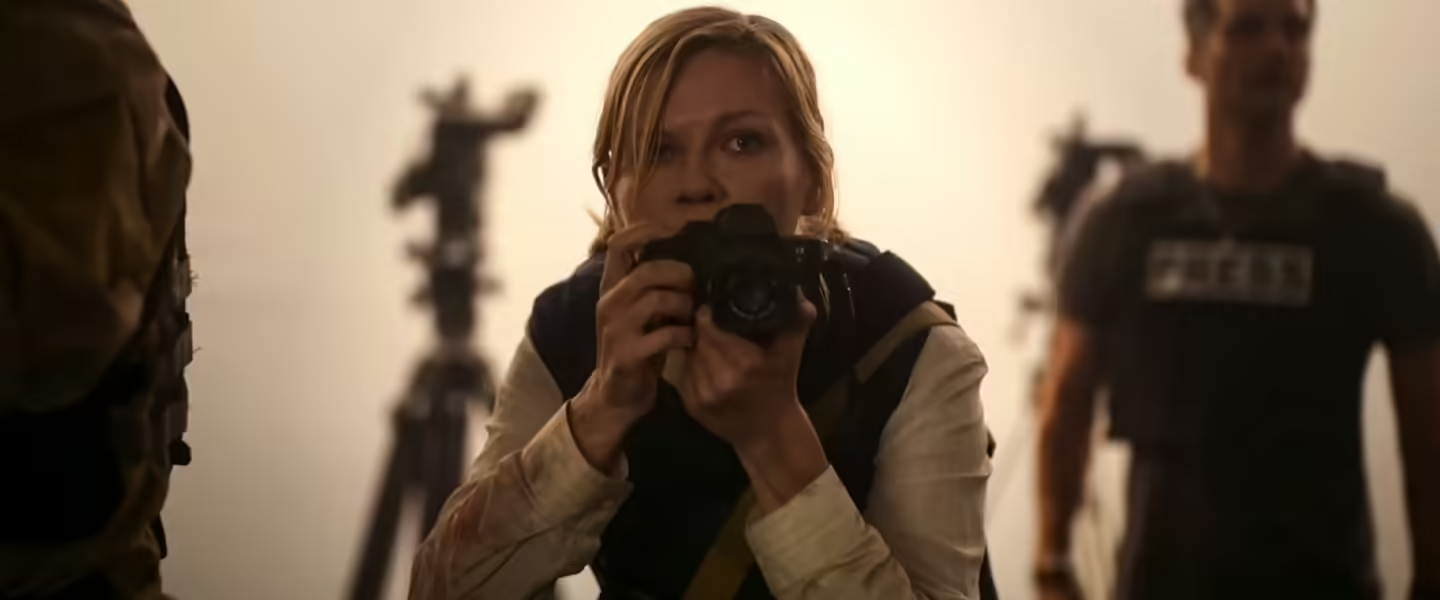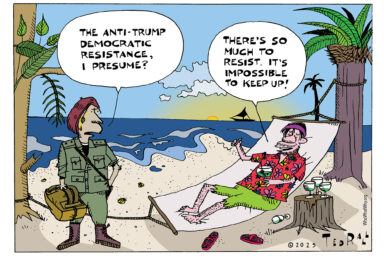Alex Garland’s ‘Civil War’ chooses beauty and cool. We have to accept the consequences for democracy.
|
Listen To This Story
|
People like it when movies are about them. Journalists are nominally people, so they too like it when movies are about them. Unfortunately, journalists also command the ability to quack on about it to the masses, and everyone has to just put up with it. To date, no one has figured out how to stop them.
I am no different. Anyone who watches journalism-related movies with me has to put up with rants about how, oh, in the Zack Snyder movies, Daily Planet editor Perry White should absolutely be fired for inventing some inflammatory headline about Superman and then demanding a story that justifies it. Or when Spotlight too realistically captures the tedium of investigations and I look at my watch and yell “It’s the priests!” at the screen. Or when by the third act of All the President’s Men, I fold my arms and scoff, “Shoot, I could bring down Nixon too if I had a Deep Throat.”
So perhaps it was an act of kindness that I went to see Alex Garland’s Civil War by myself.
Garland is an excellent director and screenwriter whose films tend toward speculative fiction — artificial intelligence in Ex Machina, environmental devastation in Annihilation. With Civil War, he presents an alternate present in which the United States has descended into armed conflict.
The president (Nick Offerman) is a fascist who has claimed a third term, disbanded the FBI, and bombs US citizens. The rebel forces include a coalition of California and Texas, which seems to have broken the brains of many reviewers who can’t reconcile this setup with any known or potential reality. Having lived in both states, it’s not hard for me to imagine a joint military action, fairly or unfairly, against New York.
The movie follows a team of journalists, led by veteran photographer Lee (Kirsten Dunst), as they travel across the war-torn terrain from NYC to DC to attempt an interview with the president. There’s also a dopamine-addicted reporter for Reuters (Wagner Moura), an elder statesman journalist (Stephen McKinley Henderson), and a young, aspiring photojournalist (Cailee Spaeny) who idolizes the flinty Lee, and whose evolution frames the movie.
The Texas/California thing doesn’t bother me, but my journalist brain obsesses over things like: Are they salaried? How is the cub reporter financing this trip? Does she have family money, like so many journalists? Is she freelancing? If so, who’s buying? For that matter, what’s the financial model for Reuters now? Is it generating enough ad revenue? Are they all just on Substack?
The journos encounter horrific things along the way. Snipers who have no idea which side they’re on, only that they’re shooting at the person shooting at them. Mass graves. Refugee camps. Our heroes tumble into one peril after another and have to sweat their way out.
At one point they reach a town that is eerily untouched by the war (the marksmen on the roofs may have something to do with this). A real journalist in this situation would smell a New Yorker feature in this willful ignorance and annoy everybody by asking all sorts of questions about conformity and security and isolationism… would do some reporting, in other words. Lee and the gang mostly stare wide-eyed, and then she tries on a dress. I came away feeling that these characters are both more incurious and more incautious than actual journalists.
This all still works. These characters are, like I think all of his characters, allegorical.
Garland’s strength was never in character. It is always in image. The best parts of his movies are the transitional point (it always comes) when reality is warped by the spectacular, when the story yields to uncanny beauty. The swirling vortex of Annihilation that the eye can’t process, the grotesquely self-birthing man in Men, the surreal robot dance number in Ex Machina: These are about the direct communication of awe.
Much of the criticism of Civil War is about how the film avoids getting into the causes of the conflict. Garland said on The Big Picture podcast that he wanted to avoid wading into the partisan causes and effects that he sees dominating our real-world culture. “The movie is in some respects non-biased, inasmuch as it just offers up events during a window of time,” he said. “But it’s not sticking flags all over the place, saying ‘Here is the intention, here’s the opinion.’”
Garland said he wanted to resist offering “reassurances” to the audience, to resist “preaching to the choir.” Hence the thousand-yard stare of the film’s protagonists, whom he envisioned as “older forms of journalists” — as opposed to, presumably, MSNBC social-justice proxies on the one hand or MAGA-hatted Fox News anchors on the other, those outlets so captured by their audiences (and advertisers) that they “have to tell their audience what they want to hear.”
Propagandists, in a sense. Garland is the son of an editorial cartoonist, grew up around journalists, and yet somehow still thinks that real-world journalists “deliberately remove bias from their reporting.” I get what he means, but this vision of objectivity is perhaps the most fantastical element of the whole project.
A few years ago, I wrote about how the climate change satire Don’t Look Up is propaganda pretending to be art. Garland is desperate to avoid that label, to a fault. Because he seems so unwilling to make a grand point about war, he ends up creating a film that resists the whole idea of making a point. I think this is too bad. If nothing else, there’s a missed opportunity to make a subtler, finer-grained, and probably more valuable point on the aesthetics, psychology, and economy of image-making.
Garland is one of let’s say a dozen top-tier visual artists in the Western world — meaning he’s a name brand with a consistently unique vision whose products are much anticipated and (clearly) much commented on. I would like to know what he has learned (or what “Lee” has learned) about how a creator of images finds those images, how the public reads and misreads them, how one balances beauty and message, how creators can and should manipulate audiences… what, in other words, Garland might have to say about the aesthetics of war, if not the ethics of it.
The closest we get is a short moment, after a gun battle, when the young photog, Jessie, nervously reviews her shots before presenting an image of a gunshot man to Lee for review. Lee looks and offers one of her few smiles. She says it’s good or great, I can’t remember. And that’s it. Nothing on how, say, one might compose an image of violence for maximum effect or empathy. Nothing about the subtle ways the media and governments might manipulate imagery to deliver a message.
I don’t need Garland to weigh in on the causes of conflict, but I’d love for him to dramatize how conflict is sold to the public, which of course is what he and his journalists have in common. But it doesn’t happen. The moment passes and takes what seems to me a better version of the film with it.
Civil War doesn’t require this and works without. But as a plot point, it would allow for some much-needed character development while allowing the film to dig into meaning about the way war is presented, without having to sacrifice its ambiguity on what war means.
But what’s perhaps most interesting about Civil War is the way these aesthetics interfere with Garland’s stated message that the film is “anti-war.”
“Movies have weird superpowers to do with what happens when you put violence and music and careful framing together,” he said in the Big Picture interview. “When it’s an anti-war movie you have to be careful” not to make it too beautiful or too cool or too compelling, he said. Otherwise, this pleasure can “undermine the film’s intention to be anti-war.” He said the music, like De La Soul’s bouncy “Say No Go” playing over an otherwise-silent gunfight, was chosen to be “abrasive and confrontational,” as opposed to the “seductive and darkly romantic” aesthetics of one of this movie’s inspirations, Apocalypse Now.
In this case, his talent betrays his mission. Because one thing Civil War can’t be is anti-war.
It can claim that it is, but its scenes of combat and destruction are visually and sonically gorgeous. It may not be politically pro-war, but it’s neurally pro-war. This is Garland’s curse as a top-tier image-maker: He can’t help rendering “war” in a way that makes it appealing.
The film is beautiful, with a great score and killer soundtrack. You can say this or that scene is repellant, but it’s a surface reading. At a deeper level is enjoyment. Pleasure at a beautiful thing seen and heard. Aesthetics, again… which is where Garland’s real commentary should (could) live.
What’s ironic is this: For all that we journalists lament the manipulations of Big Tech or government surveillance, what we’re ultimately asking for with Civil War is propaganda. We want it to be a tool for social engineering. This is odd but understandable. We want Civil War to clearly explain how things fell apart, and thereby to modify our behavior and steer us away from civil war. Garland isn’t your guy for this. What he makes, he makes too beautiful. (And he’s off working on the next chapter of his zombie saga anyway.)
Here in the real world, the near future is unclear, the signs are grim. Anything that can give us some guidance is appreciated. What would it even look like?
History tells us it would not look cool.
Remember when 1983’s ABC primetime nuclear apocalypse movie The Day After gave 100 million viewers night terrors? Such that even Ronald Reagan was moved? “It is powerfully done,” he famously wrote in his journal. “It’s very effective and left me greatly depressed.”
Like everything else in 1983, The Day After is neither beautiful nor cool. The nuclear attack, at exactly the one-hour mark of the two-hour film, is impressively rendered for its time, combining special effects with archival footage of nuclear tests for a simple neural signal: You do not want this.
The Day After does not have good music, though it does have the retro appeal of Steve Guttenberg. There is nothing aspirational in the look or the attitudes of the characters. I don’t know if this particular TV event could be called “art.” It looked and acted like things that appropriate art… but then, so does advertising. That’s what The Day After most seems like: a singular example of an anti-commercial, imploring audiences not to buy. This approach — uncool, unbeautiful — saved the world.
In a December 2023 interview, The Day After’s director told The Hollywood Reporter that
The movie may have indeed helped prevent a nuclear war. It certainly changed one person’s mind on the subject, and that person just happened to be the President of the United States. … Ultimately, it sent Reagan into such a tailspin, he signed the Intermediate Missile Range Treaty, the only treaty that ever resulted in the physical dismantling of nuclear weapons.
Journalists and critics (secretly, publicly) hoped that Civil War would do something similar. Would avert a potential democratic holocaust. But it’s not that kind of project. It’s just art.




